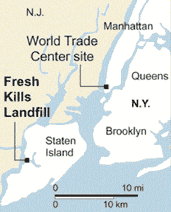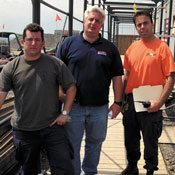

Fresh Kills
On September 11, 2001, Mayor Rudolph Guiliani, with approval from Governor George Pataki, made the decision to reopen the Fresh Kills facility to accept the wreckage of the World Trade Center. The facility was the ideal location for this operation because it could be reached by land and water. The resources of the New York City Department of Sanitation were made available and the site could be secured.
The Fresh Kills facility, which had closed in March 2001 after more than 50 years of operation, still had room to expand. However, the city wanted to return it to a wildlife refuge, and a park that offered high grassy hills, beautiful vistas and a clear view of the skyline of Manhattan. The World Trade Center was once at the center of the view toward the city. Of its 3,000 acres, 175 were secured on September 11, 2001, to receive the remains of the World Trade Center. Those acres became a New York Police Department crime scene while the other fields were left to return to a natural state.

Special Agent Richard Marx, NYPD Inspector James Luongo, and NYPD Lt. Bruce Bovino.
The operation at Fresh Kills had three objectives: to find human remains, personal effects, and any evidence of the terrorist attack such as a highjacker’s box cutter, cell phones from the planes, and the black boxes. The recovery operation evolved from simple hand-sorting into an elaborate machine-sifting and sorting process. All the material was carefully sorted to find objects down to one-quarter of an inch in size.
The recovery operation at the Fresh Kills facility was under the management of Federal Bureau of Investigation Special Agent Richard Marx, New York Police Department Inspector James Luongo, and New York Police Department Lieutenant Bruce Bovino.
The site of the recovery operation was called “The City on the Hill,” and the facility resembled just that. From an encampment without phones, running water, or electricity, Fresh Kills was transformed into a small city. Soon there were heated and air-conditioned trailers and water facilities. The Hilltop Café, run by the Salvation Army and the American Red Cross, served food and drink to more than 1,500 people a day. Structures were built around sorting tents to keep the staff comfortable and focused on their tasks. A supply tent was erected to provide everything from Tyvek suits to eyedrops and sunblock.